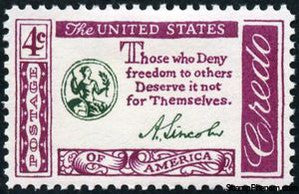
On the fateful night of April 14, 1865, President Abraham Lincoln attended a performance of "Our American Cousin" at Ford's Theatre in Washington, D.C. Little did he know that this evening would end in tragedy, as actor and Confederate sympathizer John Wilkes Booth carried out one of the most infamous acts of political violence in American history. Today, we reflect on this momentous event through the lens of postage stamps, exploring how John Wilkes Booth's assassination of Abraham Lincoln is immortalized in philately and the enduring impact it has had on the nation's history.

Abraham Lincoln, the 16th President of the United States, was a towering figure in American history, known for his leadership during the Civil War, his commitment to abolishing slavery, and his eloquent speeches that inspired a nation. However, his presidency was marked by division and conflict, culminating in his assassination at the hands of John Wilkes Booth, a Confederate sympathizer and actor with ties to the South.
On the evening of April 14, 1865, as President Lincoln watched the play at Ford's Theatre, John Wilkes Booth entered the presidential box and fired a single gunshot at point-blank range, striking Lincoln in the back of the head. The President was mortally wounded, and despite the efforts of doctors and surgeons, he passed away the following morning, on April 15, 1865.
The assassination of Abraham Lincoln sent shockwaves throughout the nation, plunging the country into mourning and sparking widespread outrage. In the days and weeks that followed, a massive manhunt was launched to capture John Wilkes Booth and his co-conspirators, leading to Booth's death in a shootout with Union soldiers.
The tragic events of April 14, 1865, reverberated far beyond Washington, D.C., shaping the course of American history and leaving an indelible mark on the nation's collective memory. The assassination of Abraham Lincoln marked the first time in American history that a sitting President had been killed, and it cast a long shadow over the process of Reconstruction and the healing of the nation's wounds after the Civil War.
One of the most poignant ways in which the assassination of Abraham Lincoln has been commemorated is through postage stamps. Since the late 19th century, both the United States and other countries around the world have issued stamps honoring Lincoln's life and legacy, as well as the tragic circumstances of his death.

One notable example of a stamp commemorating Abraham Lincoln's assassination is the 1965 issue by the United States Postal Service, which marked the centennial anniversary of Lincoln's death. This stamp featured a somber portrait of Lincoln, serving as a poignant reminder of the President's untimely demise and the impact it had on the nation.
In addition to official postage stamps, the assassination of Abraham Lincoln has also been commemorated through various philatelic initiatives, including commemorative covers, first-day covers, and stamp albums. These tributes serve as enduring testaments to Lincoln's enduring legacy and the enduring impact of his presidency on American history.
Beyond their philatelic value, stamps commemorating the assassination of Abraham Lincoln play a crucial role in preserving and promoting the memory of this historic event for future generations. They serve as educational tools, sparking interest in American history and the Civil War among collectors, historians, and enthusiasts alike.
As we commemorate the assassination of Abraham Lincoln today, let us not only remember the tragic loss of a great leader but also reflect on the enduring legacy of his presidency and the lessons we can learn from this pivotal moment in American history. Through the power of postage stamps, we honor the memory of Abraham Lincoln and ensure that his legacy lives on for generations to come.
Sources:
- Library of Congress: https://www.loc.gov/
- Smithsonian National Postal Museum: https://postalmuseum.si.edu/
- National Archives: https://www.archives.gov/


